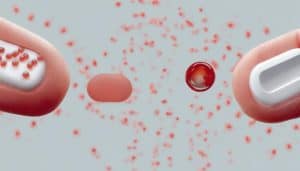You can alleviate red eyes without relying on eye drops by addressing the underlying causes, modifying your daily habits, and incorporating simple remedies into your routine. Take breaks from screens, rest your eyes from contact lenses, and apply warm compresses to soothe and calm your eyes. Identify and avoid irritating substances, prioritize hydration, and practice good eye hygiene. By making these changes, you'll be on the path to clearer, healthier eyes. And, as you continue to explore, you'll uncover even more strategies to keep your eyes feeling and looking their best.
Key Takeaways
• Apply warm compresses to soothe and calm the eyes, reducing redness and promoting healing.
• Take breaks from screens and irritants to reduce redness and promote faster recovery.
• Stay hydrated by drinking at least 6-8 glasses of water daily to keep eyes comfortable and clear.
• Practice good eyelid hygiene by gently cleaning eyelids to reduce irritation and maintain proper contact lens hygiene.
• Get enough sleep, limit screen time, and avoid smoke and allergens to support eye health and reduce redness.
Understanding Red Eye Causes
Identifying the root cause of your red eyes is crucial, as it can be a symptom of a more serious underlying condition, such as an infection, allergy, or inflammation. Red eyes can be a sign of something more serious, and it's vital to understand what's causing the redness.
You might be surprised to learn that dry eye is a common culprit behind red eyes. When your eyes don't produce enough tears or the tears are of poor quality, it can lead to inflammation and redness.
In addition to dry eye, allergies, infections, and irritants can also cause red eyes. If you're experiencing itchiness, burning, or discharge along with redness, it could be an allergic reaction or infection. Corneal ulcers, a serious eye condition, can also cause red eyes.
It's crucial to identify the underlying cause to determine the best course of treatment. Treating red eyes without understanding the cause can lead to temporary relief at best and exacerbate the condition at worst.
You should be aware that red eyes can be a symptom of a more serious medical condition that requires attention and treatment. By understanding the root cause of your red eyes, you can take the necessary steps to address the underlying issue and find effective relief. Remember, red eyes aren't just a cosmetic issue; they can be a sign of a deeper problem that needs attention.
Giving Your Eyes a Break

By giving your eyes a break from the constant strain and irritants, you can greatly reduce redness and inflammation, promoting a faster recovery. Prolonged exposure to screens, allergens, and environmental stressors can exacerbate eye problems, making it essential to provide your eyes with regular respite.
Taking breaks from wearing contact lenses is also important for maintaining good eye health. This allows your eyelids to rest and reduces the risk of irritation and redness.
Applying a warm compress to your eyes can soothe and calm them, reducing pain and promoting healing. This simple technique can work wonders for various eye problems.
When it comes to contact lenses, consider switching to rigid gas permeable (RGP) or silicone hydrogel lenses, which offer improved comfort and eye health benefits. Scleral lenses, in particular, provide exceptional comfort and oxygen flow to the eyes, making them an excellent option for those seeking excellent eye health.
Contact Lens Care Essentials
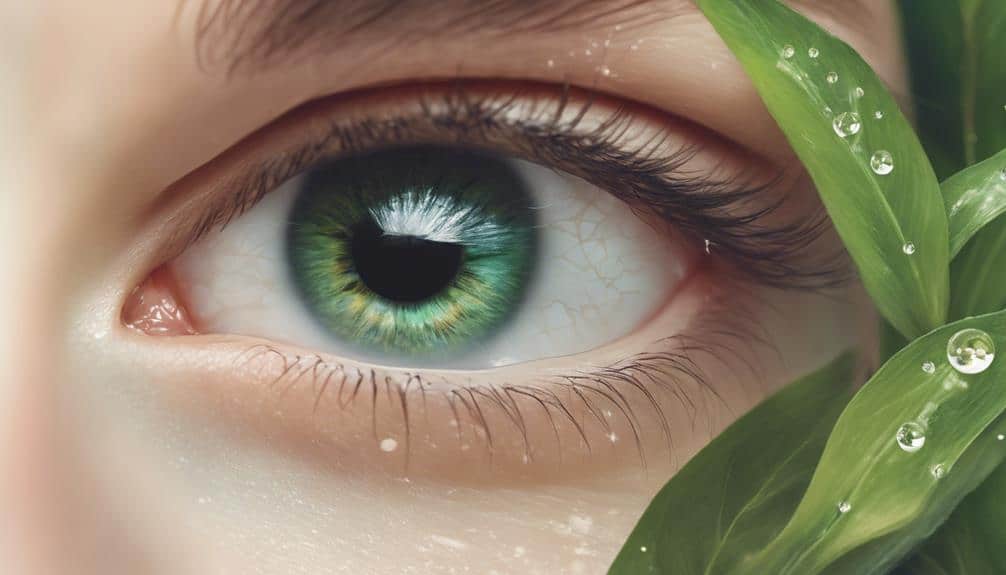
As you focus on clearing red eyes without eye drops, it's important to prioritize contact lens care essentials.
You'll want to master lens hygiene essentials, such as proper cleaning and disinfecting, as well as develop a daily cleaning routine to keep your lenses fresh.
Lens Hygiene Essentials
You must prioritize proper contact lens hygiene, including regular cleaning and disinfecting, to prevent red eyes and other complications. When wearing contact lenses, it's essential to maintain good hygiene practices to avoid eye irritation and redness. This includes cleaning and disinfecting your lenses regularly, as well as replacing them as prescribed by your eye care professional.
In addition to proper hygiene, you should avoid wearing contact lenses for extended periods or sleeping with them on, as this can increase the risk of eye irritation and redness. Consider using rigid gas permeable (RGP) or silicone hydrogel lenses, which allow more oxygen to reach the eye and reduce redness.
Taking breaks from wearing contact lenses periodically can also help give your eyes a rest and prevent redness. By following these guidelines, you can reduce the risk of red eyes and other complications associated with contact lens wear.
If you experience persistent red eyes or discomfort, consult an eye care professional for personalized advice and treatment options.
Proper Storage Tips
Proper storage of your contact lenses is vital in preventing eye irritation and redness, and it starts with storing them in a clean case with fresh solution. This guarantees that your lenses remain clean and free of bacteria, which can cause eye infections and redness.
As a contact lens wearer, you should replace your contact lens case every 3 months to prevent bacterial growth and potential eye infections. Additionally, avoid using tap water to clean or store your contact lenses, as it can introduce harmful microorganisms.
It's also essential to follow your eye care provider's instructions for proper contact lens care and storage to maintain clear, healthy eyes. Remember, never sleep in your contact lenses, as this can increase the risk of corneal ulcers, red eyes, and other complications.
Daily Cleaning Routine
By incorporating a daily cleaning routine into your contact lens care regimen, you'll greatly reduce the risk of eye irritation and redness. Start by washing your hands thoroughly with soap and water before handling your contact lenses. This simple step will help prevent the transfer of bacteria and other microorganisms to your eyes.
Next, clean and disinfect your contact lenses according to your eye doctor's instructions to prevent the buildup of bacteria and other contaminants. Make sure to store your lenses in a clean case with fresh solution to prevent bacterial growth. Additionally, replace your contact lens case every three months to maintain excellent eye health.
Avoiding Irritating Substances

When it comes to avoiding irritating substances, you'll want to take a proactive approach to protect your eyes.
You'll need to be mindful of harsh chemicals, allergenic substances, and excessive screen time, all of which can exacerbate redness and discomfort.
Avoid Harsh Chemicals
Identifying and avoiding harsh chemicals lurking in your makeup, cleaning products, or personal care items can trigger eye irritation and redness. You can reduce the risk of red eyes by being mindful of the products you use.
| Product Category | Chemicals to Avoid | Better Alternatives |
|---|---|---|
| Makeup | Parabens, artificial fragrances | Hypoallergenic, fragrance-free products |
| Cleaning Products | Ammonia, bleach | Eco-friendly, non-toxic cleaners |
| Personal Care | Sulfates, artificial dyes | Gentle, natural ingredients |
When shopping for products, always read the labels and opt for gentle, natural ingredients. Avoid rubbing your eyes vigorously, as this can introduce additional irritants and worsen redness. If you accidentally expose your eyes to harsh chemicals, rinse them with clean water and seek medical advice if the redness persists. By being proactive and avoiding harsh chemicals, you can reduce the occurrence of red eyes and maintain healthy, comfortable vision.
Identify Allergenic Substances
You can greatly reduce the risk of red eyes by pinpointing and avoiding common allergens that trigger eye irritation. Identifying these allergens is important in preventing red eyes.
Start by recognizing common culprits like pollen, dust, pet dander, and mold. These allergens can easily trigger eye irritation, leading to redness and discomfort.
To minimize exposure to these allergens, take proactive measures. During high pollen seasons, keep your windows closed to prevent pollen from entering your home. Use air purifiers to remove allergens from the air. Regularly wash your bedding in hot water to remove allergens and reduce eye irritation. When outdoors, consider wearing wrap-around sunglasses to protect your eyes from outdoor allergens like pollen.
Maintaining a clean and dust-free indoor space is also essential. Regularly clean and dust surfaces to minimize exposure to allergens that can cause redness in the eyes.
Limit Screen Time
Prolonged screen time can greatly worsen red eyes, making it essential to limit your daily exposure to digital screens. This is because staring at screens for extended periods can reduce your blink rate, leading to dry eyes and increased redness.
To minimize the negative effects of screen time on your eyes, follow these guidelines:
- Take breaks every 20 minutes to blink and rest your eyes
- Adjust the brightness and contrast of your screens to reduce eye strain
- Position your screens directly in front of you, about arm's length away
- Consider using blue light filtering glasses or software to reduce eye fatigue
Hydration for Eye Health

Drinking enough water is vital to maintaining proper hydration levels, as dehydration can exacerbate eye redness and discomfort. As you go about your day, it's essential to prioritize hydration to keep your eyes comfortable and clear.
You see, when you're dehydrated, your eyes can become dry, itchy, and red, which can be quite uncomfortable.
To combat this, aim to drink at least 6-8 glasses of water daily to support peak eye function and reduce redness. However, this is just a general guideline, and you should adjust your water intake based on individual needs, health conditions, and environmental factors.
For instance, if you're physically active or live in a hot climate, you may need to drink more water to stay hydrated.
In addition to drinking water, you can also consume water-rich foods like cucumbers, watermelon, and oranges to contribute to your overall hydration and eye health.
Omega-3 Rich Food Benefits
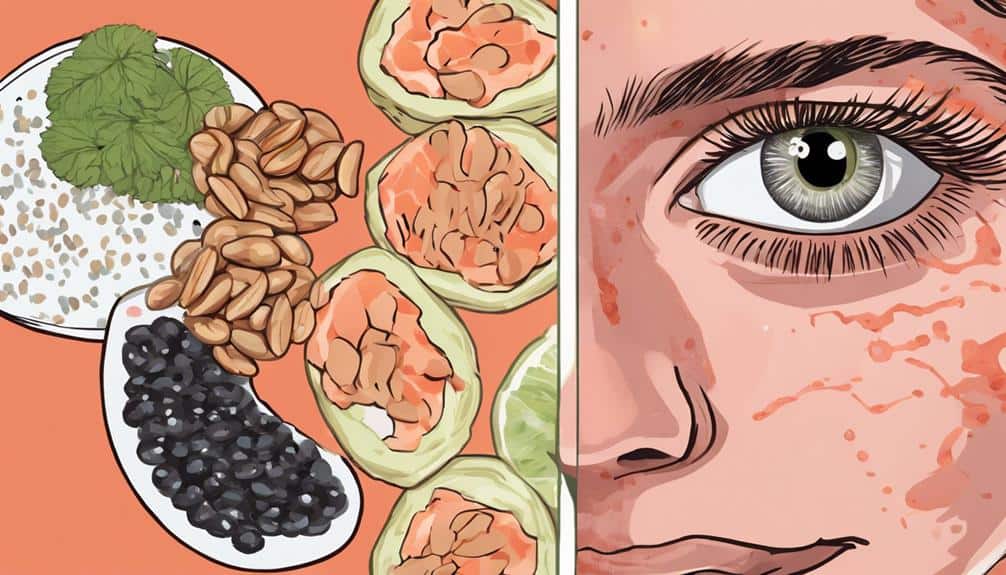
By incorporating omega-3 rich foods into your diet, you can harness the anti-inflammatory properties of these nutrients to support eye health and potentially alleviate redness. Omega-3 fatty acids have been shown to reduce inflammation in the eyes, which can contribute to redness.
Incorporating omega-3 rich foods into your diet can have a range of benefits for your eye health. Some of the key benefits include:
- Improving tear quality and reducing redness in the eyes
- Promoting better eye lubrication and alleviating dry eye syndrome
- Providing a protective effect on the eyes, potentially lowering the risk of eye conditions that cause redness
- Contributing to overall eye health and potentially alleviating redness without the need for eye drops
Vitamin Power for Eye Health
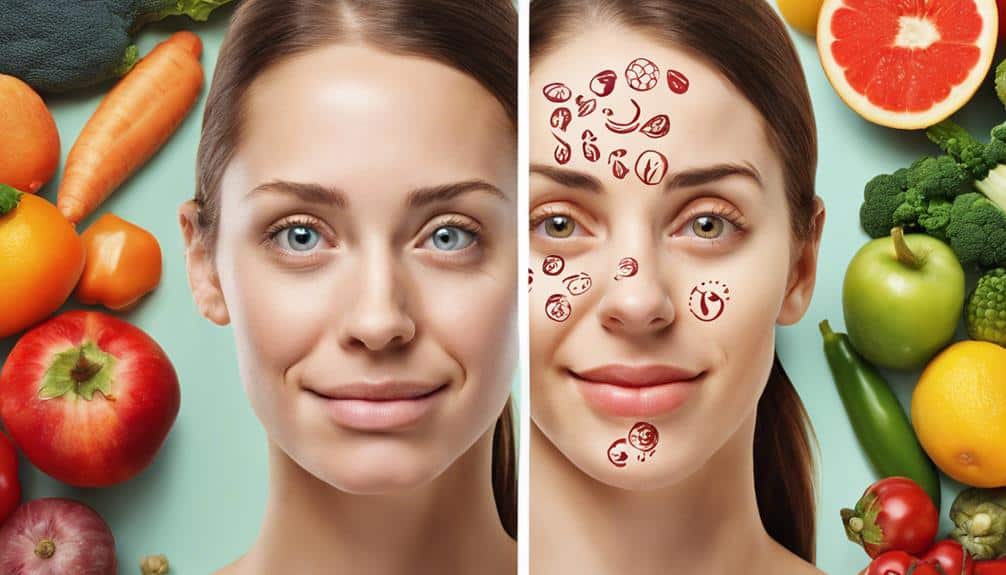
As you explore the world of vitamin power for eye health, you'll discover the triple threat of Vitamin C Benefits, Antioxidant Eye Shield, and Omega-3 Boost.
These powerful nutrients work together to protect your peepers from damage and alleviate redness.
Vitamin C Benefits
Vitamin C, an essential antioxidant, plays a significant role in reducing inflammation in your eyes, leading to clearer and brighter eyes. By incorporating vitamin C-rich foods into your diet, you can say goodbye to pesky eye redness.
Here are just a few ways vitamin C benefits your eye health:
- Reduces inflammation: Vitamin C's antioxidant properties help combat oxidative stress, reducing inflammation that can cause eye redness.
- Supports healthy circulation: Vitamin C helps maintain healthy blood vessels in your eyes, promoting clear and bright vision.
- Boosts immune system: Adequate vitamin C intake strengthens your immune system, reducing the risk of eye infections that can cause redness.
- Provides an extra boost: Vitamin C supplements can provide an additional layer of protection for your eyes, helping to combat redness without relying on eye drops.
Antioxidant Eye Shield
Your eyes have a powerful ally in antioxidant eye shields, which can neutralize free radicals and reduce inflammation that causes redness. As you incorporate antioxidant-rich foods into your diet, you'll be providing your eyes with a natural defense against oxidative stress and inflammation. Vitamins C and E are potent antioxidants that can help combat free radicals, promoting healthier eyes and reducing redness.
Omega-3 Boost
You can further fortify your eyes' natural defenses against redness by harnessing the anti-inflammatory power of omega-3 fatty acids. These essential fatty acids, found in fish oil, have been shown to reduce inflammation in the eyes and promote overall eye health.
By incorporating omega-3 rich foods or supplements into your diet, you can alleviate symptoms of dry eye syndrome, a common cause of red eyes.
Here are some ways to boost your omega-3 intake:
- Fatty fish like salmon are rich in omega-3s
- Walnuts, chia seeds, and flaxseeds are plant-based sources of omega-3s
- Omega-3 supplements provide a convenient way to boost your intake
Incorporating omega-3 rich foods or supplements into your diet may contribute to clearer, healthier eyes without the use of eye drops.
Proper Eye Hygiene Practices
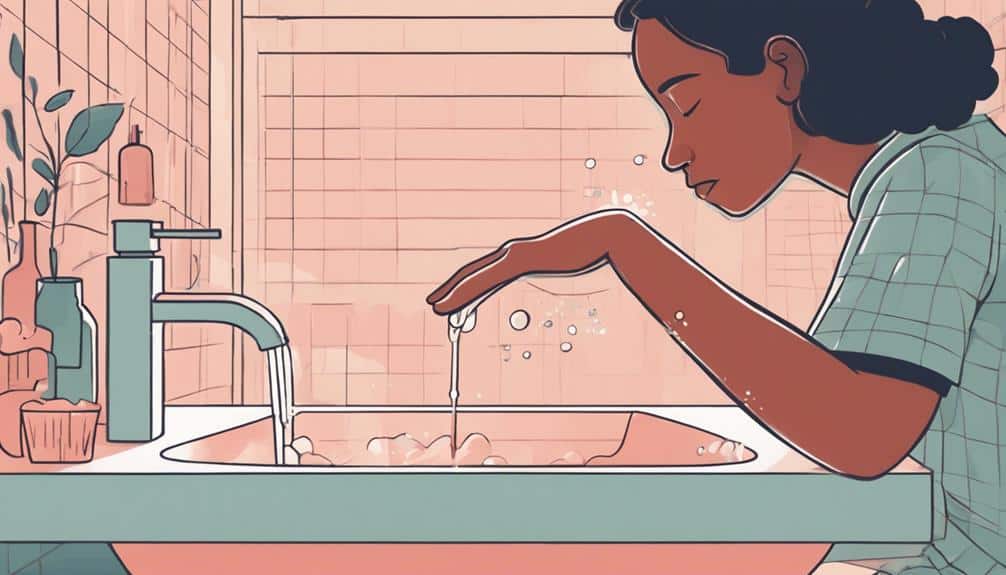
How do you maintain healthy eyes without relying on eye drops? Proper eye hygiene practices are essential to reduce redness and maintain overall eye health.
Start by practicing good eyelid hygiene. Gently clean your eyelids to reduce irritation and inflammation. This important step can make a significant difference in maintaining healthy eyes.
Next, use warm compresses on your eyes to soothe redness and promote circulation, aiding in the natural healing process. This technique is especially effective in reducing puffiness and redness.
Another vital habit to adopt is to avoid rubbing your eyes, as this can worsen redness and potentially cause damage to the delicate blood vessels.
If you wear contact lenses, maintain proper contact lens hygiene, including regular cleaning and disinfecting, to prevent eye irritation and redness.
Reducing Screen Time Effectively

Prolonged screen time is a common culprit behind red eyes, and reducing your screen time can greatly alleviate eye strain and discomfort. By guaranteeing your exposure to digital devices, you can decrease eye dryness and irritation caused by blue light emission.
Here are some effective ways to reduce your screen time:
- Take regular breaks from screens by following the 20-20-20 rule: every 20 minutes, look at something 20 feet away for 20 seconds.
- Adjust your screen brightness and use blue light filters or computer glasses to minimize eye strain.
- Maintain proper lighting in the room and uphold good posture while using screens to reduce eye discomfort.
- Incorporate eye exercises and blink frequently to keep your eyes moist and comfortable.
Common Red Eye Triggers

Red eyes can be triggered by a multitude of factors, including allergies, dry eye, and eye infections, which can cause inflammation and discomfort in the eyes. As you navigate your daily life, you're exposed to various substances and environments that can irritate your eyes, leading to redness and discomfort.
| Common Causes | Description | Prevention Tips |
|---|---|---|
| Allergies | Pollen, pet dander, or dust triggering an allergic response | Avoid exposure, use air purifiers, and wash hands frequently |
| Dry Eye | Insufficient tear production or evaporation | Blink regularly, use humidifiers, and avoid screens before bed |
| Irritants | Smoke, dust, or chemical exposure | Wear protective gear, avoid strong chemicals, and quit smoking |
Other common causes of red eyes include lack of sleep, prolonged screen time, and improper contact lens use. Environmental factors like pollution and not getting enough hydration can also contribute to redness. By identifying and avoiding these triggers, you can reduce your reliance on eye drops and take a more holistic approach to clearing red eyes.
Natural Remedies for Relief

To alleviate redness and discomfort without relying on eye drops, incorporate these natural remedies into your daily routine. By making a few simple changes, you can alleviate eye problems and maintain clear, healthy eyes.
Here are some natural remedies to consider:
- Apply a warm compress to your eyes to reduce inflammation and discomfort.
- Practice good eyelid hygiene to prevent redness and irritation, helping your eyes stay clear naturally.
- Take breaks from wearing contact lenses to give your eyes a chance to rest and recover.
- Stay hydrated by drinking enough water throughout the day to keep your eyes moisturized and reduce redness.
Can Increasing Oxygen Intake Help Clear Red Eyes Without Eye Drops?
Increasing oxygen intake through deep breathing exercises and regular physical activity can help improve blood circulation and clear red eyes naturally, without relying solely on eye drops. By following tips for oxygenating blood, such as yoga and aerobic exercises, individuals can experience better overall eye health and reduce redness.
Frequently Asked Questions
How to Get Rid of Red Eyes Fast?
To get rid of red eyes fast, you're looking for quick relief. Start by applying a warm compress to reduce inflammation.
Next, rest your eyes for a few minutes to alleviate redness.
Stay hydrated by drinking plenty of water to prevent dryness.
Avoid irritants like smoke and dust, and practice good eyelid hygiene to prevent infections.
What Can I Use Instead of Red Eye Drops?
You've got a million things to try before reaching for those red eye drops! Instead, grab a warm washcloth and gently press it against your peepers to reduce redness and inflammation.
Alternatively, try flushing your eyes with artificial tears or a saline solution.
For a more natural approach, use a rosewater or chamomile compress to soothe and calm your eyes.
How to Get Rid of Red Eyes High Without Eye Drops?
You're wondering how to get rid of red eyes when you're high without relying on eye drops.
First, acknowledge that THC can cause bloodshot eyes. To combat this, stay hydrated by drinking plenty of water to keep your eyes moist.
Take a warm shower to relax and reduce puffiness. Then, apply a warm compress to your eyes to soothe irritation.
These steps will help alleviate redness without eye drops, ensuring you feel more comfortable and confident.
How Do You Tone Down Red Eyes?
To tone down red eyes, you'll want to tackle the underlying causes. Start by applying a cold compress to constrict blood vessels and reduce redness.
Practice good hygiene to prevent infections, and get plenty of rest to promote overall eye health. Staying hydrated also helps.
Conclusion
As you emerge from the storm of red, irritated eyes, a calm sea of clarity awaits.
By heeding the tips outlined above, you'll navigate the treacherous waters of eye irritation and dock safely at the harbor of healthy, happy eyes.
Remember, a clear horizon begins with a single step – take control of your eye health today, and let the soothing breeze of comfort envelop you.



